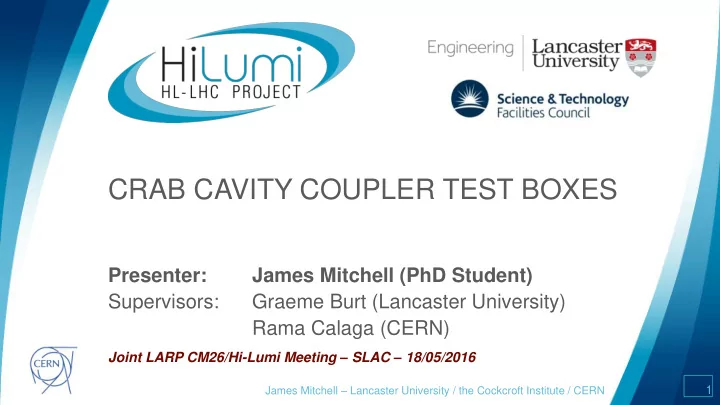

CRAB CAVITY COUPLER TEST BOXES Presenter: James Mitchell (PhD Student) Supervisors: Graeme Burt (Lancaster University) Rama Calaga (CERN) Joint LARP CM26/Hi-Lumi Meeting – SLAC – 18/05/2016 logo area James Mitchell – Lancaster University / the Cockcroft Institute / CERN 1
Introduction and Outline FPC Test Box DQW HOM Coupler Test Boxes Fundamental power couplers (FPCs) couple Frequency response of HOM couplers is power into the cavity at 400 MHz. sensitive to geometric variations. Couplers operational frequency needs to be Therefore the frequency response should be checked after manufacture. characterised before installation; ensuring there are no significant geometric deviations. Prior to installation, FPCs need to be conditioned in order for suitable operation at Two low power DQW HOM coupler test boxes high power. have been designed and the construction stage is well underway. Test box capable of characterisation and high power conditioning has been designed. High power versions and test boxes for the RFD HOM couplers are being investigated. DQW HOM coupler hook cross section with LC stop-band structure (a) DQW (left) and RFD (right) HOM coupler hooks and an L-shaped pass- band filter (b). logo area James Mitchell – j.a.mitchell@lancaster.ac.uk 2
FPC Test Box • Test box design is based on a Quarter Wave Resonator (QWR). • The design allows the testing and conditioning of both the DQW and RFD FPCs – reducing cost and time needed – two sets of ‘false walls’ required to allow correct insertion depths. • The structure has been designed to operate at the deflecting mode frequency (400 MHz) . • A high transmission between the coupler ports allows conditioning of the couplers at high power (~ 100 kW) in order to prepare them for operation on the respective crab cavities. • A ‘dual’ coupler test box has also been designed. The orientation of the couplers needed to be altered in order to ensure good coupling between the fields and hence a good transmission. L-Electric (top) and magnetic (bottom) fields in DQW FPC test box. James Mitchell – j.a.mitchell@lancaster.ac.uk 3
DQW HOM Coupler Test Boxes Two test boxes have been designed for characterisation of the HOM coupler frequency response; the coaxial chamber and the L-bend transmission line . Both designs allow accurate measurement of the HOM coupler response. The test boxes will therefore allow any errors in operation to be quantified – the corresponding error causing geometries can then be identified. Coaxial chamber test box Constructed from rigid line components which are commercially available. L-bend transmission test box S21 frequency responses Uses L-shaped probes to pick up transmission characteristics of HOM James Mitchell – j.a.mitchell@lancaster.ac.uk 4 couplers.
Test Box Manufacture For the FPC test box, currently the CAD is being finalised. A re-design means the same test box can now be used for the DQW and RFD FPCs. For the DQW HOM coupler test boxes: The L-Bend transmission line test box body (below) has been machined at Lancaster University. The probes are currently under manufacture. The coax chamber is in its final design and optimisation stages. Following this, procurement of the parts and CAD drawings of the few necessary adaptations will be made. Example of rigid line components to be used on the test box. James Mitchell – j.a.mitchell@lancaster.ac.uk 5
Conclusions Test box capable of testing and conditioning both types of FPC for each of the DQW and RFD crab cavities has been designed Currently the CAD is currently being finalised. Following this, the construction of the single test box with ‘false walls’, for differing insertion depths, need to be constructed. For the dual test box, the false walls will be made rotatable in order to allow variation of the orientations. Two test boxes have been designed for the DQW HOM couplers. Coax chamber – very robust to manufacturing tolerances. L-bend transmission line – more accurate characterisation of the deflecting mode frequency (400 MHz) but also more sensitive to manufacturing errors. Coax chamber design is almost finalised, the HOM coupler ports for the coax chamber will be machined at CERN and fitted onto the outer conductor of the rigid line coaxial chamber. The L-bend probe is currently being manufactured at Lancaster University engineering department. Further Work Investigate DQW HOM coupler test boxes at high power – started. Design/adapt test boxes for RFD HOM couplers – started. James Mitchell – j.a.mitchell@lancaster.ac.uk 6
Recommend
More recommend